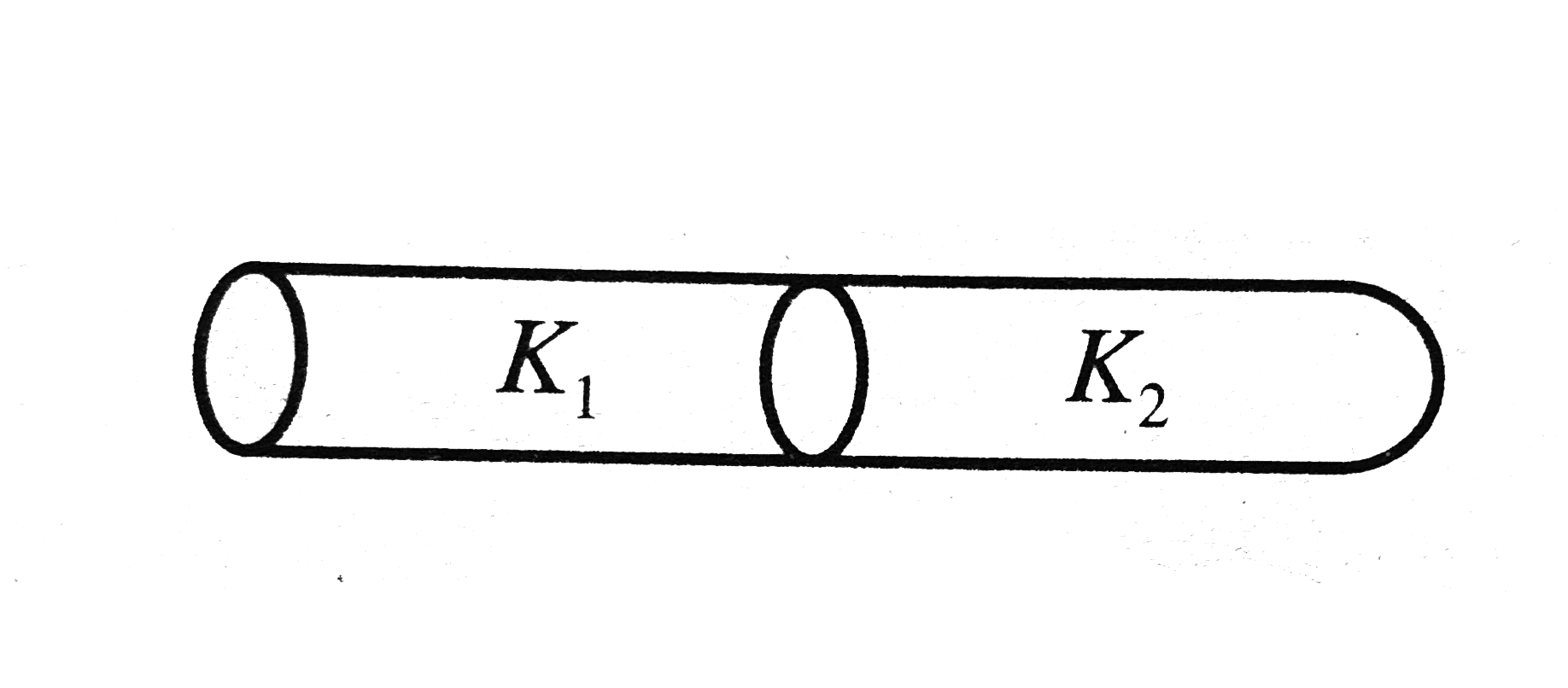Two identical metal wires of thermal conductivities K1 and K2 respectively are connected in series. The effective thermal conductivity of the combination is :
K1+K2K1K2
K1K2K1+K2
2K1K2K1+K2
K1+K22K1K2
To find the effective thermal conductivity of two identical metal wires connected in series, we can follow these steps:
Step 1: Understand the concept of thermal conductivity in series
When two materials are connected in series, the heat transfer through each material must be the same. The effective thermal conductivity can be derived from the heat transfer equations for each wire.
Step 2: Write down the heat transfer equations
For a wire of length L and cross-sectional area A, the heat transfer Q through a wire can be expressed as:
Q=K⋅A⋅ΔTL
where K is the thermal conductivity, ΔT is the temperature difference across the wire, and L is the length of the wire.
Step 3: Set up the equations for both wires
Let the temperature difference across wire 1 be ΔT1 and across wire 2 be ΔT2. The heat transfer through both wires must be equal:
K1⋅A⋅ΔT1L=K2⋅A⋅ΔT2L
Since the wires are identical, we can cancel A and L from both sides:
K1⋅ΔT1=K2⋅ΔT2
Step 4: Relate the temperature differences
The total temperature difference ΔT across both wires is:
ΔT=ΔT1+ΔT2
From the previous equation, we can express ΔT2 in terms of ΔT1:
ΔT2=K1K2ΔT1
Step 5: Substitute into the total temperature difference equation
Substituting ΔT2 into the total temperature difference equation gives:
ΔT=ΔT1+K1K2ΔT1=ΔT1(1+K1K2)
Step 6: Solve for ΔT1
Rearranging gives:
ΔT1=ΔT1+K1K2=K2⋅ΔTK1+K2
Step 7: Find the effective thermal conductivity
Now, substituting ΔT1 back into the heat transfer equation for wire 1:
Q=K1⋅A⋅ΔT1L=K1⋅A⋅K2⋅ΔTK1+K2L
This can be simplified to:
Q=K1K2⋅A⋅ΔTL(K1+K2)
Step 8: Identify the effective thermal conductivity Keff
By comparing this with the general heat transfer equation Q=Keff⋅A⋅ΔTL, we can identify:
Keff=K1K2K1+K2
Final Answer
Thus, the effective thermal conductivity of the combination is:
Keff=K1K2K1+K2
---
When two materials are connected in series, the heat transfer through each material must be the same. The effective thermal conductivity can be derived from the heat transfer equations for each wire.
For a wire of length L and cross-sectional area A, the heat transfer Q through a wire can be expressed as:
Q=K⋅A⋅ΔTL
where K is the thermal conductivity, ΔT is the temperature difference across the wire, and L is the length of the wire.
Let the temperature difference across wire 1 be ΔT1 and across wire 2 be ΔT2. The heat transfer through both wires must be equal:
K1⋅A⋅ΔT1L=K2⋅A⋅ΔT2L
Since the wires are identical, we can cancel A and L from both sides:
K1⋅ΔT1=K2⋅ΔT2
The total temperature difference ΔT across both wires is:
ΔT=ΔT1+ΔT2
From the previous equation, we can express ΔT2 in terms of ΔT1:
ΔT2=K1K2ΔT1
Substituting ΔT2 into the total temperature difference equation gives:
ΔT=ΔT1+K1K2ΔT1=ΔT1(1+K1K2)
Rearranging gives:
ΔT1=ΔT1+K1K2=K2⋅ΔTK1+K2
Now, substituting ΔT1 back into the heat transfer equation for wire 1:
Q=K1⋅A⋅ΔT1L=K1⋅A⋅K2⋅ΔTK1+K2L
This can be simplified to:
Q=K1K2⋅A⋅ΔTL(K1+K2)
By comparing this with the general heat transfer equation Q=Keff⋅A⋅ΔTL, we can identify:
Keff=K1K2K1+K2
Thus, the effective thermal conductivity of the combination is:
Keff=K1K2K1+K2
Topper's Solved these Questions
- JEE MAIN 2021BOOK - JEE MAINS PREVIOUS YEARCHAPTER - JEE MAIN 2021EXERCISE - PHYSICS (SECTION B)
30 Videos
- JEE MAIN 2021BOOK - JEE MAINS PREVIOUS YEARCHAPTER - JEE MAIN 2021EXERCISE - PHYSICS SECTION A
60 Videos
- JEE MAIN 2021BOOK - JEE MAINS PREVIOUS YEARCHAPTER - JEE MAIN 2021EXERCISE - (SECTION - B)
10 Videos
- JEE MAINBOOK - JEE MAINS PREVIOUS YEARCHAPTER - JEE MAINEXERCISE - All Questions
473 Videos
- JEE MAIN 2022BOOK - JEE MAINS PREVIOUS YEARCHAPTER - JEE MAIN 2022EXERCISE - Question
492 Videos
Similar Questions
 Statement I: Two solid cylindrical rods of identical size and different thermal conductivity K1 and K2 are connected in series. Then the equivalent thermal conductivity of two rods system is less than that value of thermal conductivity of either rod.
Statement I: Two solid cylindrical rods of identical size and different thermal conductivity K1 and K2 are connected in series. Then the equivalent thermal conductivity of two rods system is less than that value of thermal conductivity of either rod.
Statement II: For two cylindrical rods of identical size and different thermal conductivity K1 and K2 connected in series, the equivalent thermal conductivity K is given by 2K=1K1+1K2
View SolutionTwo rods of the same length and diameter having thermal conductivities K1 and K2 are joined in parallel. The equivalent thermal conductivity of combination is
View Solution
Knowledge Check
Two rods of equal length and diameter but of thermal conductivities 2 and 3 unites respectively are joined in parallel. The thermal conductivity of the combination is:
A1B1.5C2.5D5Two rods of the same length and diameter, having thermal conductivities K1 and K2, are joined in parallel. The equivalent thermal conductivity to the combinationk is
AK1K2K1+K2BK1K2CK1+K22D√K1K2Two rods of equal length and diameter have thermal conductivity 3 and 4 units respectively. If they are joined in series, the thermal conductivity of the combination in the given units would be
A3.43 unitsB4.43 unitsC5.43 unitsD2.43 units
Two rods of the same length and diameter having thermal conductivities K1 and K2 are joined in parallel. The equivalent thermal conductivity of combination is
View SolutionThe coefficient of thermal conductivity of a metal depends on
View SolutionTwo springs of spring constantsK1 and K2 are joined in series. The effective spring constant of the combination is given by
View SolutionConsider a compound slab consisting of two different material having equal thickness and thermal conductivities K and 2K respectively. The equivalent thermal conductivity of the slab is
View SolutionTwo spring of spring constant k1 and k2 are joined in series The effective spring constant of the combination is given by
View Solution
